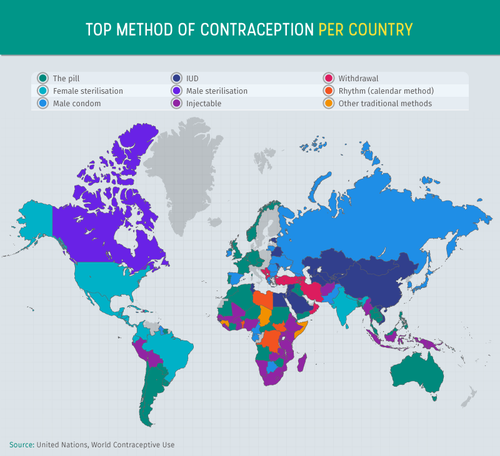Millions of people around the world use contraception every day to avoid unwanted pregnancies, but the methods of contraception we reach for are very different.
Using data from a UN report which surveyed the contraceptive use of married women and women in relationships, the team at Superdrug Online Doctor have created insightful graphics showing the stark differences.
Overall short-term methods are more common in Europe, permanent and long-acting reversible contraception (LARCs), such as male sterilisation and IUDs, are more popular in North America and Asia, and in Africa around two-thirds of couples use no contraception at all.


The graphics reveal that female sterilisation is the top choice of contraception in the United States and northern South America, while male sterilisation is preferred in Canada and IUDs dominate much of Asia.
In contrast the pill is popular in Western Europe, Australia, several countries in Africa and the southern part of South America.
Male condoms are the top method in Russia, much of Eastern Europe, and some countries in Africa, while injectables remain the top choice in other parts of Africa.
Despite being listed as one of the "least effective" ways of preventing pregnancy, the withdrawal method is more popular in Europe than any other continent around the world.
A total of 7.8% of the European women surveyed said they rely on the withdrawal method.
However, that's not to say people in the UK are risking pregnancies when they have sex.
We're listed as the second top country for using "more effective" methods of contraception, with the pill being the most popular method here.
At the other end of the scale, Albania was found to be the country most likely to rely on "less effective" methods.
There, the withdrawal method is most popular which may have something to do with the fact that the Albanian government actually banned contraception until 1992.
The Superdrug Online Doctor report concludes that there are many reasons why contraception varies so much from country to country.
It states that higher initial cost, dependence on providers for information, and provider bias may all contribute to "the underutilisation of long-term reversible birth control methods such as IUDs in certain countries".
"Additionally, in many areas, couples have limited access to family planning services, limited choice of birth control methods, and poor quality of available services," it adds.
"Other hurdles include cultural or religious opposition, fear of adverse effects, and gender-based barriers to obtaining birth control."
After reading the global results, we're pretty content with life here in the UK.